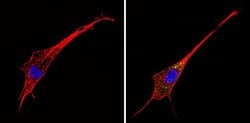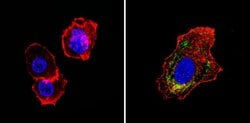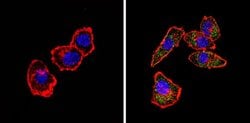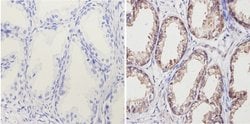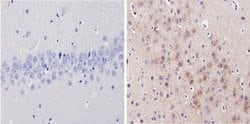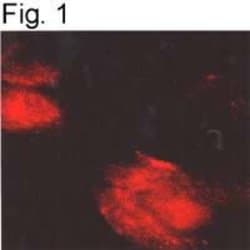Learn More
Invitrogen™ alpha-1a Adrenergic Receptor Polyclonal Antibody
Rabbit Polyclonal Antibody
Supplier: Invitrogen™ PA1047
Description
PA1-047 detects alpha-1 adrenergic receptor (A1AR) from human, mouse, rat, zebra fish (Danio rerio) and Drosophila samples. PA1-047 has been successfully used in Western blot, immunohistochemistry and immunofluorescence procedures. By Western blot, this antibody detects an ~60 kDa protein representing the A1AR from mouse kidney membrane preparations, mouse liver, HeLa cell lysates, zebra fish and drosophila samples. Immunofluorescence staining of A1AR in mouse kidney distal tubule cells with PA1-047 results in staining of the plasma membrane. The PA1-047 immunogen is a synthetic peptide corresponding to residues K(339) F S R E K K A A K T(349) of the 3rd intracellular loop of human A1AR. This sequence is 100% conserved in all A1AR subtypes examined. PA1-047 immunizing peptide (Cat. # PEP-216) is available for use in neutralization and control experiments.
Adrenergic receptors (ARs) are members of the 7-transmembrane domain G-protein-coupled receptor superfamily that bind the endogenous catecholamines epinephrine and norepinephrine. Pharmacological, structural, and molecular cloning data indicate significant heterogeneity within this receptor family. Nine receptor subtypes have been identified thus far including three alpha-1 AR subtypes (1A/D, 1B, and 1C), three alpha-2 ARs (2A, 2B, and 2C), and three beta AR subtypes (1, 2, and 3). ARs participate in either the onset or maintenance of several disease states including hypertension, cardiac dysfunction (congestive heart failure, ischemia, arrhythmias), diabetes, glaucoma, depression, and impotence. A1AR subtypes are found in numerous tissues and have been shown to be involved in the regulation of blood pressure due to changes in vascular tone and cardiac output. Effects on uterine contraction, hepatic glucose metabolism, heat shock protein 70 (HSP70), proto-oncogene expression, and mitogenesis have been linked to A1AR activation. Norepinephrine can increase nitric oxide synthase (NOS) levels in the hypothalamus by activating alpha-1 AR which may indirectly suppress the release of luteinizing hormone (LH), the androgens, estrogen, and progesterone.
Specifications
| alpha-1a Adrenergic Receptor | |
| Polyclonal | |
| Unconjugated | |
| ADRA1A | |
| ADA1; adra1a; adra1aa; Adra1c; ADRA1L1; adrenergic alpha 1c receptor; adrenergic receptor alpha 1c subtype; adrenergic receptor, alpha 1a; adrenergic receptor, alpha 1c; adrenergic, alpha-1A-, receptor; adrenergic, alpha-1Aa, receptor; adrenoceptor alpha 1A; adrenoceptor alpha 1Aa; alpha 1A-adrenoceptor; alpha 1A-adrenoreceptor; alpha 1C-adrenergic receptor; alpha-1A adrenergic receptor; Alpha-1A adrenoceptor; alpha-1A adrenoreceptor; ALPHA1AAR; Alpha-1C adrenergic receptor; Alpha1C-AR; Alpha-adrenergic receptor 1c; fc18h12; G protein coupled receptor; wu:fc18h12 | |
| Rabbit | |
| Antigen affinity chromatography | |
| RUO | |
| 11549, 148, 29412, 798498 | |
| -20°C, Avoid Freeze/Thaw Cycles | |
| Liquid |
| Immunohistochemistry (Paraffin), Western Blot, Immunocytochemistry | |
| 0.5 mg/mL | |
| PBS with 1 mg/mL BSA and 0.05% sodium azide | |
| P35348, P43140, P97718 | |
| ADRA1A, adra1aa | |
| Synthetic peptide corresponding to residues K(339) F S R E K K A A K T(349) of the 3rd intracellular loop of human A1AR. | |
| 100 μL | |
| Primary | |
| Human, Mouse, Rat, Drosophila, Zebrafish | |
| Antibody | |
| IgG |
Safety and Handling
Your input is important to us. Please complete this form to provide feedback related to the content on this product.
